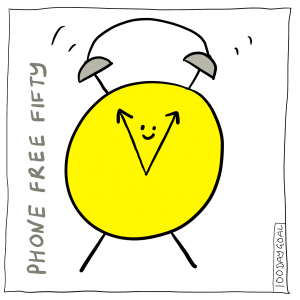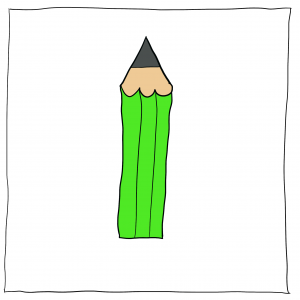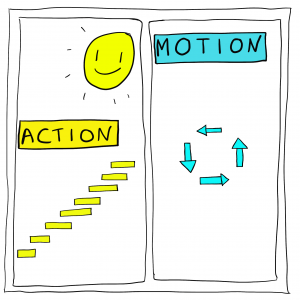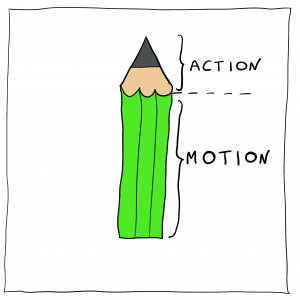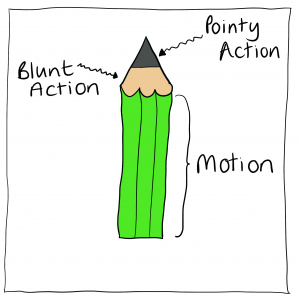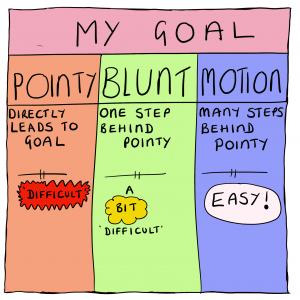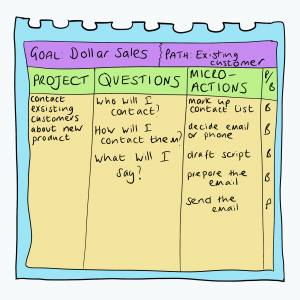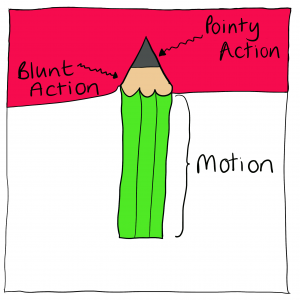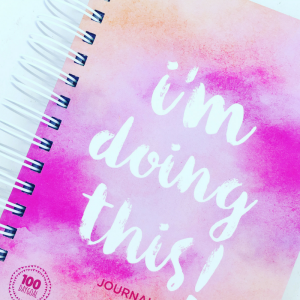
If you’re serious about your 100 Day Goal, then you really should use a 100 Day Goal Journal, or, as I like to call it, a “Goal-Keeper”, because it makes the process so much easier.
[You can see the contents of a 100 Day Goal Journal at the bottom of this post]
Inside your subconscious brain there are three important systems that, when activated, will help you reach your 100 Day Goal. They systems are smart and helpful and make showing-up for your Microactions each day much, much, easier. But these systems don’t start working until you activate them.
The easiest way to activate all three systems, and keep them activated all day, is to use a 100 Day Goal Journal. I’ll explain how this works in a minute, but first, the three systems:
The “three systems”
The three systems inside your subconscious brain are:
- The Reticular Activating System
- The Dopamine Reward System
- The Habit System
The Reticular Activating System (RAS) is the barrier around your subconscious brain which keeps 99% of info out of it. When you activate your RAS it allows info relevant to your goal to enter your subconscious. This is important because:
- You will see opportunities to reach your goal that otherwise your brain would reject.
- You’re subconscious will create patterns out of the 100 Day Goal “data” it receives and that will help you generate good ideas (you will feel much more creative!)
- You’re subconscious will help you find the time to do your Microactions (because your subconscious is designed to help you achieve the goals you set it)
The Dopamine Reward System is the workings of your brain that makes you feel motivated and energised. When you achieve something, or anticipate achieving something, the Ventral Tegmental Area in your brain produces a chemical called Dopamine which travels across to another part of the brain where it latches on to cells and creates the feeling you know as “motivation”. Activating your Dopamine Reward System is important because it makes you feel energised and excited to do your Microactions, and this makes doing them much easier!
The Habit System is the way in which tasks move from being ones that you consciously do, to ones that you do automatically (like brushing your teeth, or driving a car). Tasks that you perform consciously take much more effort than those you perform automatically so that’s why you want to turn daily Microactions into a habit.
Here’s how to use your 100 Day Goal Journal to activate the three systems
The three systems need to be activated multiple times a day to keep them on. But it’s not hard when you know how. In fact if you do all the things below, you’ll activate parts of your subconscious brain twenty times a day. So that’s 2000 times during the 100 days. Given that activating your subconscious brain makes achieving your goal easier, by doing these very simple, two second activities you’ll make reaching your goal 2000 times EASIER. What’s not to love about that?!
- Keep your Journal on your Kitchen bench so you see it first thing in the morning. This does two things:
- Seeing your journal is a cue ( a reminder) for your Habit System to start the Microaction Habit
- Seeing your Journal reminds your subconscious brain that your Goal is important to you (so allows “goal” stuff into your brain and starts working on it)
- Early-ish in the morning, write your Goal at the top of the day’s page (each day of the 100 Day Goal has it’s own page). Writing your Goal sends a strong message to your subconscious brain that your Goal is important and it should work on it for you. Remember there is a special connection between handwriting and your subconscious: stuff gets into your subconscious more quickly, and it stays longer, when you hand write it. Writing your Goal down:
- Reminds your subconscious that your goal is important so it keeps your RAS open
- Triggers the Dopamine Reward System. Your subconscious can’t differentiate between thinking about achieving your goal and actually achieving it, so it gets excited and thinks you’ve achieved it and sends a burst of Dopamine across your brain and makes you feel energised and motivated!
- The night before, write the three Microactions you are going to do tomorrow. If you can’t do it the night before, do it early in the morning (you can do it at the same time as you write your goal). I suggest doing it the night before so you don’t use up your “willpower/decision making” muscle thinking about doing the work rather than actually doing it! Writing what Microactions you are going to do:
- Reminds your subconscious that your goal is important so it keeps your RAS open
- Primes your subconscious to want to work on your Microactions, because once your subconscious says it’s going to do something (which it’s done by writing out the Microactions for the day) it likes to be consistent and follow through! [Remember the story about the green energy company who tripled their sign up rate by anonymously calling homeowners three days before their visit and simply asking the question “Is the Environment important to you?” , Because homeowners answered “yes” to this innocuous question, their brains then led them to behave in a manner consistent with this answer and they changed service provider to the green energy company]
- Separates the hard work of making decisions from the hard work of doing the Microaction, and this makes it easier to actually do the Microaction when the time comes!
- Helps you use little bubbles of time to do your Microaction (you can get straight on with the task rather than having to waste your time-bubble deciding what to do!)
- Initiates a “craving” repsonse in the Habit Centre of your brain. This sounds weird but your brain will start to crave the feeling of having ‘done’ your Microaction – and writing down what you are going to do stimulates this!
- When you’ve done your Microactions, write down what you did. Just a few words will do. Writing what you did:
- Gives you a sense of achievement, which ignites the Dopamine Reward System and you’ll get another burst of motivation (which should carry across to tomorrow)
- Keeps your RAS open
- Gives your Habit System a “reward” – when your brain gets a “reward” for action it reinforces the habit and your brain prepares to get you to show up again tomorrow
- When you’ve done your Microactions you also put a cross in your “Don’t Break the Chain” box. Like writing down the Microactions (point 4), putting a cross in your “Don’t Break the Chain”
- Gives you a sense of achievement, which ignites the Dopamine Reward System and you’ll get another burst of motivation (which should carry across to tomorrow)
- Keeps your RAS open
- Gives your Habit System a “reward” – when your brain gets a “reward” for action it reinforces the habit and your brain prepares to get you to show up again tomorrow
- If you’ve made progress towards your Goal, colour in a section of your Goal Tracker. This also:
- Gives you a sense of achievement, which ignites the Dopamine Reward System and you’ll get another burst of motivation (which should carry across to tomorrow)
- Keeps your RAS open
- Gives your Habit System a “reward” – when your brain gets a “reward” for action it reinforces the habit and your brain prepares to get you to show up again tomorrow
- Finally, before you go to bed, open your Journal again and write down any “good news”. This can be as simple as “I’m happy I showed up and did my Microactions” or it can be detailed such as “Had good conversations with XX, think YY will join my team” or it can simply be how you’re feeling about your goal, your business or your life! Writing your good news makes your brain feel happy and this ignites the Dopamine Reward System again, priming it for another burst of motivation tomorrow. It also floods your brain with happy chemicals which make you feel content and relaxed and are brilliant for a good night’s sleep!
Making your own 100 Day Goal Journal – what it must include
I sell hard copy 100 Day Goal Journals, (and they come in the bundles too). I had them made because I was fed up of setting up blank Journals beforehand. What I found was that it was important to have the “prompts” in there ready to go, otherwise I didn’t fill the Journal out properly, and it didn’t work so well!
So you can either get one of our Journals, or, make your own – but if you’re going to do that set up each page properly now, before we start, or you’ll find it hard to stick to it.
To make your own 100 Day Goal Journal, get a blank book with at least 100 Pages and mark up each page like this:
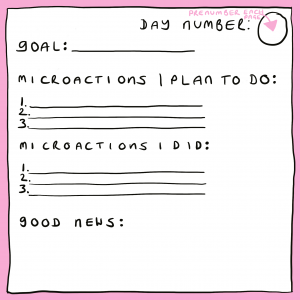
Write in the day number 1-100 now, rather than each day, so if you miss a day you’ll have a blank page (this is useful psychologically!) but don’t write your goal in yet, do that one each day (see point 2 above)
Now create a “Don’t Break The Chain” . You need to pre-write the numbers (otherwise you could cheat by skipping a number and not breaking the chain!). Here’s an example:
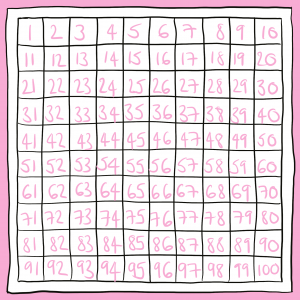
Now create your Goal Tracker. You can decide how many “things” to colour in. I always pick 100 (!) so if my goal is $1000, I just colour one item for every $10. You can do whatever suits you! Here’s a very simple goal tracker. I actually use the “Bunting” one I showed in my presentation because I like pretty!
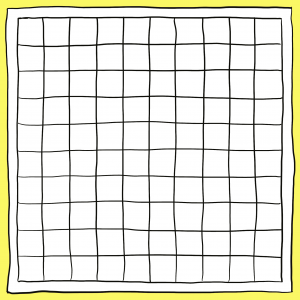 And that’s it!
And that’s it!
If you’re committed to achieving your goal, keep a 100 Day Goal Journal because it really will make the whole thing feel very much easier! Two thousand times easier!
If you have any questions email me: julia@100daygoal.com.au

